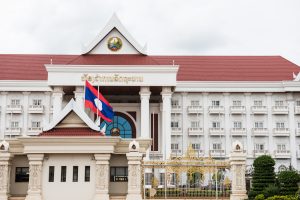The ratings agency Fitch has announced that it will withdraw its rating for the government of Laos, as the country continues to grapple with one of its worst economic crises in years.
“Fitch Ratings plans to withdraw the ratings on Laos in approximately 30 days from the date of this commentary for commercial reasons,” the agency said in a statement yesterday. The rating agency did not offer further clarification, except to say that it “reserves the right in its sole discretion to withdraw or maintain any rating at any time for any reason it deems sufficient.”
But the withdrawal falls in the midst of Laos’ worst economic crisis this century. Much of this is connected to the country’s heavy burden of debt, much of it owed to Chinese state banks in connection with infrastructure mega-projects. The country’s debt now totals $14.5 billion dollars, according to the World Bank.
Informed observers have been warning about the country’s shaky finances for years, but it was the onset of the COVID-19 pandemic in early 2020 that nudged the country toward the point of crisis, by cutting off vital sources of revenue, such as tourism.
In August 2020, even before the country had recorded a single case of COVID-19, Fitch downgraded Laos’ credit rating to the junk rating of CCC, expressing its concern about the government’s “deepening external liquidity pressures as a result of the coronavirus shock and the sovereign’s large debt maturities.”
As Fitch then noted, the country owed $1.1 billion in annual repayments for 2021-24, compared to its then foreign exchange reserves of $1.3 billion. This was the same month that Laos, citing its low foreign reserves, announced that it was ceding majority control of its national power grid to a state-owned Chinese company. According to Fitch, CCC ratings are accorded to entities with a “very low margin for safety” and for whom “default is a real possibility.”
In the two years since, things have only worsened, to the extent that they have begun to impact the availability of vital goods such as fuel. Laos is currently caught in the pincer grip of rising oil prices and a rapidly depreciating currency, which has led to runaway increases in the price of energy and consumer goods. Last month, year-on-year inflation reached 25.6 percent, the largest jump since the aftermath of the Asian financial crisis in 1998 and 1999. The inflation has been most severe in the communications and transport category (53.2 percent), largely due to soaring global oil prices and the weak state of the Lao kip.
In August, Fitch further lowered Laos’ sovereign credit rating to CCC-, due to “a further rise in external liquidity risks, driven most recently by the spike in commodity prices and tightening global financing conditions.”
“Laos’ external debt repayment profile is challenging amid narrow financing options, surging inflation, currency depreciation, and low foreign-exchange reserves,” the agency stated. “The Lao government has prioritized repayment of private debt obligations in recent years, but we believe risks are growing due to these external liquidity strains.”
The withdrawal of the rating, which Moody’s rating agency says occurs when the agency “believes it has insufficient or otherwise inadequate information to support the maintenance of the Credit Rating,” testifies to the uncertainty of Laos’ predicament. Much of its debt is debt owed privately to state-owned Chinese enterprises, and the government appears set on negotiating directly with Beijing in order to restructure some of its debts. However this process plays out in the short term, and the country’s economic travails appear far from over.

































